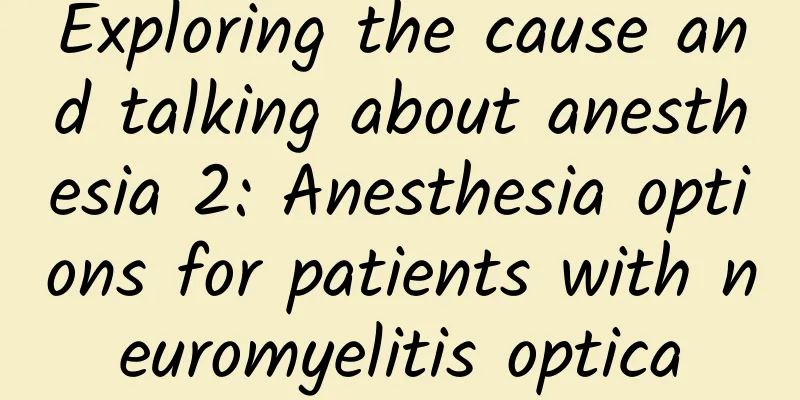Exploring the cause and talking about anesthesia 2: Anesthesia options for patients with neuromyelitis optica

|
A 60-year-old female patient was admitted to the hospital for "aseptic necrosis of the femoral head and right femoral neck fracture" and was scheduled to undergo "right total hip replacement". The patient visited the hospital three months ago for "lower back pain" and was diagnosed with "neuromyelitis optica". She is currently taking glucocorticoids (methylprednisone) and immunosuppressants (mycophenolate mofetil). First, let’s take a brief look at neuromyelitis optica. Neuromyelitis optica, also known as neuromyelitis optica spectrum disorders (NMOSD), is a group of autoimmune-mediated inflammatory demyelinating diseases of the central nervous system that primarily affect the optic nerve and spinal cord [1]. NMOSD was once considered a subtype of multiple sclerosis (MS), but in recent years, an increasing number of studies have shown that the vast majority of NMOSD cases are caused by pathogenic immunoglobulin G autoantibodies against aquaporin 4 (AQP4-IgG), and that it is an independent disease different from MS. NMOSD is less life-threatening, but has a high relapse rate and high disability rate. The highest risk factor for NMOSD is female. The main clinical features are optic neuritis and transverse myelitis. Its core symptoms are: optic neuritis, acute myelitis, area posterior syndrome, acute brainstem syndrome, acute diencephalic syndrome, and cerebral syndrome. The diagnostic principle of NMOSD is based on "medical history + core clinical symptoms + imaging features + biomarkers", with AQP4-IgG (specificity 90%, sensitivity 70%) as the stratification, and reference to other subclinical and immunological evidence to make a diagnosis. In addition, other diseases must be excluded. The "lower back pain" that this patient had three months ago was radicular pain caused by acute myelitis. After this admission, the results of the head MRI examination are shown in the figure below. Unfortunately, we did not obtain MRI images of the patient's spinal cord. Figure 1: Extensive white matter lesions Figure 2: The optic nerve is thickened and enhanced, with the posterior segment involved; the optic chiasm has high signal Figure 3: Multiple microhemorrhages Regarding anesthesia for this NMOSD patient, we discussed two core issues: 1. Should glucocorticoids and immunosuppressants be stopped before surgery? 2. Choice of anesthesia regimen Regarding the use of preoperative glucocorticoids and immunosuppressants, according to the consensus statement issued by the Society for Perioperative Assessment and Quality Improvement (SPAQI) in 2022, glucocorticoids should continue to be used before surgery, including on the day of surgery, while blood glucose should be monitored; mycophenolate mofetil should continue to be used before surgery, including on the day of surgery, based on the central nervous system changes clearly indicated by the patient's MRI (Figures 1 and 2), while blood routine, electrolytes, and creatinine should be monitored [2]. We have two different opinions on the choice of anesthesia method. 1. Support general anesthesia NMOSD is an inflammatory demyelinating disease characterized by optic nerve and transverse myelitis. Local anesthetics have certain neurotoxicity when in contact with nerves, which can cause nerve damage including demyelination. The contraindications of spinal anesthesia in Clinical Anesthesiology (4th Edition) clearly point out that "central nervous system diseases, especially spinal cord or spinal nerve root lesions, may cause long-term paralysis after spinal anesthesia." At the same time, Miller's Anesthesiology (7th Edition) points out that "relative contraindications often cited for pre-existing neurological diseases are not based on medical standards, but are included from a legal perspective." Therefore, even for potential legal risks, general anesthesia should be chosen. 2. Support for spinal anesthesia NMOSD is an autoimmune disease, and its nonspecific autoantibodies can cause brain damage and cognitive dysfunction [3]. In mouse experiments, researchers have confirmed that AQP4-IgG significantly activates astrocytes, releases a large number of inflammatory factors, and significantly inhibits the proliferation and differentiation of hippocampal neural stem cells, thereby causing related cognitive dysfunction. At the same time, the patient's cranial MRI showed multiple microbleeds (Note: Microbleeds are different from hemorrhages. They are small blood vessels in the brain that leak. Macrophages phagocytize hemoglobin and form iron-containing hemoglobin deposits around small blood vessels, indicating increased fragility of small blood vessels in the brain); the patient had a history of hypertension and cerebral infarction, which indicated that the patient had a fragile brain and general anesthesia might increase the risk of cognitive dysfunction. Epidural anesthesia produces a blocking effect through paravertebral blockade, transradicular arachnoid villus blockade of spinal nerve roots, and diffusion of local anesthetics through the dura mater into the subarachnoid space. The anesthesia guidelines for MS (which has similar inflammatory demyelinating damage and clinical symptoms to NMOSD) [5] state that “epidural anesthesia is not directly related to worsening of the disease.” This patient had the first onset of NMOSD. After 3 months of treatment, he currently has no back or limb pain. Therefore, epidural anesthesia is an option in the non-acute phase. Finally, we informed the patient and his family of the two anesthesia options in detail. After careful consideration, the patient chose epidural anesthesia and signed an informed consent form. The intraoperative anesthesia plane was satisfactory and the patient had no discomfort. Postoperative follow-up (once a week) showed that the patient had no limb paralysis and gradually began rehabilitation training. Five weeks after surgery, the patient reported decreased vision in the left eye, but no difference in limb strength and sensation. The affected side was consistent with the preoperative cranial MRI (Figure 2. The left optic nerve and optic chiasm were affected). The effect of the choice of anesthesia on the optic nerve is still unknown, but epidural anesthesia did not aggravate or cause recurrence of myelitis in the short term. References 1. Neuroimmunology Branch of Chinese Society of Immunology. Chinese Guidelines for the Diagnosis and Treatment of Neuromyelitis Optica Spectrum Disorders (2021 Edition)[J]. Chinese Journal of Neuroimmunology and Neurology, 2021, 28(6): 423-436. DOI: 10.3969/j.issn.1006-2963.2021.06.002. 2. Adriana D, Oprea, Maureen C, Keshock, Avital Y, O'Glaser, Kenneth C, Cummings, Angela F, Edwards, Paula C, Zimbrean, Richard D, Urman, Karen F, Mauck. Preoperative Management of Medications for Psychiatric Diseases: Society for Perioperative Assessment and Quality Improvement Consensus Statement.[J]. Mayo Clinic proceedings,2022,97(2):397-416.DOI:10.1016/j.mayocp.2021.11.011. 3. Zhong Xiaoling, Jia Shuangshuang, Qiu Feng. Research progress on brain magnetic resonance imaging in patients with cognitive impairment in neuromyelitis optica spectrum disorder[J]. Chinese Medical Journal, 2023, 103(21): 1653-1656. DOI: 10.3760/cma.j.cn112137-20221219-02674. 4. Wei, Jiang, Fan, Zhu, Huiming, Xu, Li, Xu, Haoyang, Li, Xin, Yang, Shabbir, Khan Afridi, Shuiqing, Lai, Xiusheng, Qiu, Chunxin, Liu, Huilu, Li, Youming, Long, Yuge, Wang, Kevin, Connolly, Jack A, Elias, Chun Geun, Lee, Yaxiong, Cui, Yu-Wen Alvin, Huang, Wei, Qiu, Changyong, Tang. CHI3L1 signaling impairs hippocampal neurogenesis and cognitive function in autoimmune-mediated neuroinflammation.[J]. Science advances, 2023, 9(39): eadg8148. DOI: 10.1126/sciadv.adg8148. 5. CI,Efrimescu,S,Donnelly,DJ,Buggy.Systemic sclerosis. Part II: perioperative considerations.[J].BJA education,2023,23(3):101-109.DOI:10.1016/j.bjae.2022.10.003. Wang Jingyu, Department of Anesthesiology, PLA 903 Hospital [Warm Tips] Follow us, there are a lot of professional medical knowledge here, revealing the secrets of surgical anesthesia for you~ |
>>: Breast hyperplasia is not a disease, it will accompany you for life, don't worry
Recommend
What is the difference between light and dark colors of sea cucumbers? What are the methods of stewing sea cucumber with pork ribs?
There are many varieties of sea cucumbers. Accord...
What is the normal blood sugar level for pregnant women?
The normal blood sugar value is between 3.9 and 6...
Why do we have so many dental problems?
Leviathan Press: If you look around at the people...
How to massage your breasts yourself
Regular breast massage can help unclog the mammar...
If you don’t get hemorrhoids, you can be called a koi!
Recipient: Little Agent Old Detective Topic: Hemo...
What are the symptoms of endometriosis?
Endometriosis is actually not uncommon among wome...
What kind of apple is a yellow apple? What kind of apple is a milk apple?
Apple is a deciduous tree belonging to the genus ...
What is peach gum? What are the benefits of peach gum?
It is said that women are made of water, which me...
When will a woman go through menopause?
Menstruation is an important physiological phenom...
How to choose guava? When is the best time to eat guava?
Recently, fresh autumn fruits have matured. Today...
How long can I sleep after general anesthesia surgery?
You should be able to stay awake 2-6 hours after ...
How long does a cesarean section surgery take?
The emergence of cesarean section can actually so...
Can I express breast milk after a miscarriage?
For some women who have had miscarriage, they oft...
Causes of white vaginal discharge
Gynecological diseases are not common in women, a...
Can I breastfeed if I have heat stroke during breastfeeding?
Generally, the quality of milk will be affected o...









